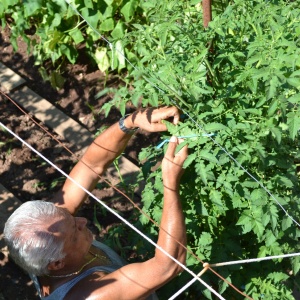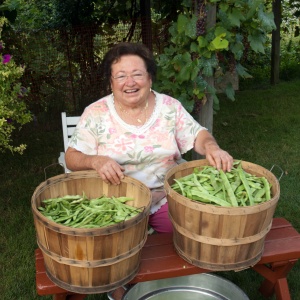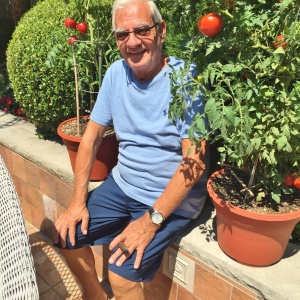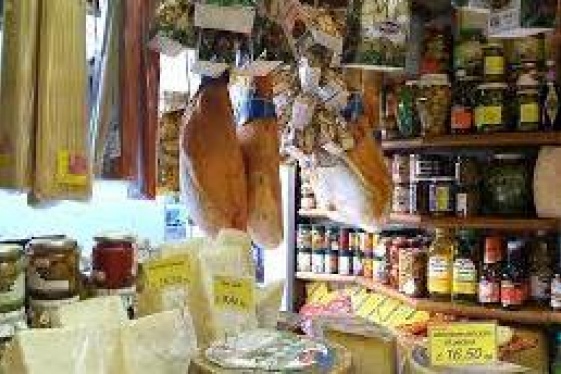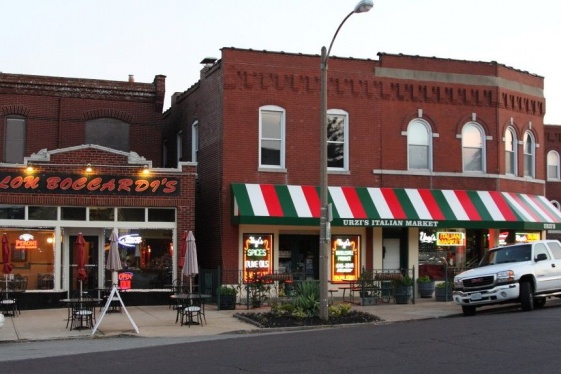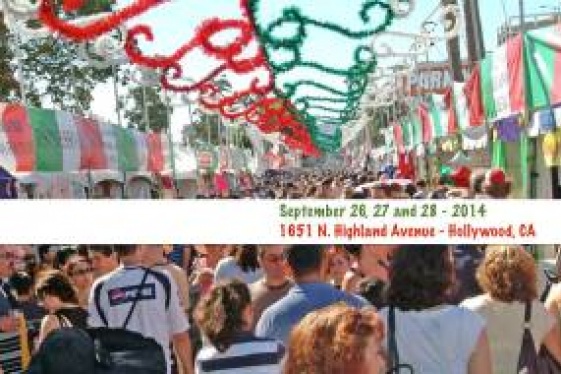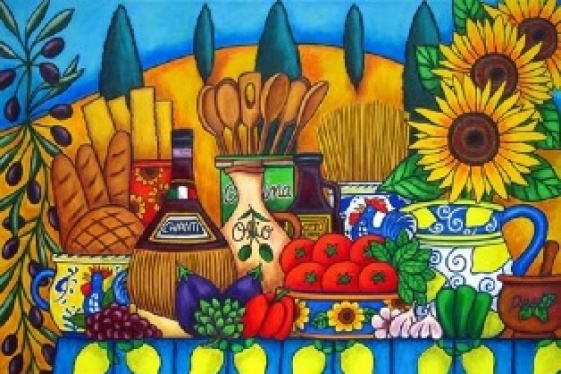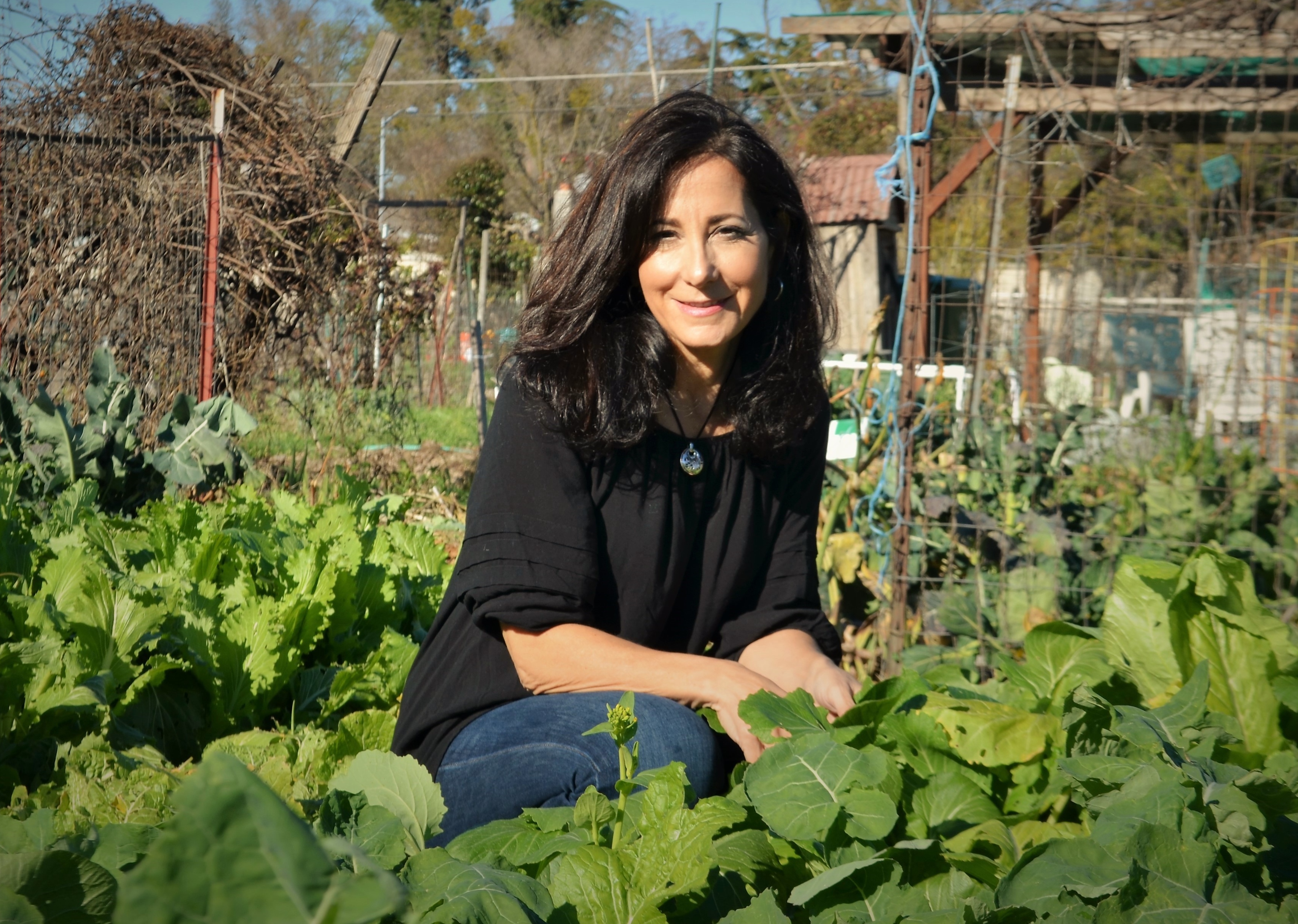
Mary Menniti (Founder of The Italian Garden Project)
Natura, cibo e famiglia: l'Italian Garden Project

The Italians who arrived in America during the period of the late nineteenth and early twentieth century, and then also those who came after the Second World War, had some very precise characteristics. They were poor. They were used to a lot of work. They were able to do extraordinary things with their hands. They were willing to live off what they could get, thanks to their creativity and sacrifice. They came from places where they cultivated their land. These characteristics led them to create small gardens where they worked the land and grew fruit and vegetables with which to eat, and also earn, selling it.
Today, when the return to the land, to health, to simplicity are fundamental factors of good living, refined and rare, the quality of Italian gardens in America is increasingly valuable and avant-garde. Mary Menniti is working on it with her The Italian Garden Project, telling the wonderful stories of Italians and their successes in this field. We welcome her on We the Italians
Mary, you are the founder of "The Italian Garden Project". Please tell us what it is, and how did you come out with this idea?
The Italian Garden Project is a documentation and preservation project that looks deeply at the connection between Italian Americans and their backyard vegetable gardens. We have long known that there is a natural connection between Italian Americans and gardens, but there has been little study focused on unraveling that connection and asking why is this so. What is it about the Italian character that loved growing things and having their hands in the earth? How did having gardens shape and nurture our families, and what have we lost as a culture when we have lost our gardening tradition?
We try to answer these questions by shining a light on the last of our Italian American gardeners, primarily Italian-born Americans who came here after WWII and who are now in their 70s, 80s and 90s. The backyard vegetable garden remains central to their way of life, and they live closer to the earth and much more lightly on the earth than most of us do today. They are so “old school” that they’re now considered cutting edge, living in a way many of us are trying to get back to. They have much to teach us about the past that is vital and relevant for today.
Unfortunately, this lifestyle is slipping away before our eyes. The Italian Garden Project’s mission is a document and preserve as much of it as possible while we still have access to it. The project is led by me, but often with volunteers from across the country. We visit these gardeners, learning everything we can from them, such as how they plant and cook fava beans, how to forage for mushrooms, and how to save seeds from season to season. We photograph, video, do interviews, and garden sketches, often making multiple visits. Although we do our best, we’ll never learn it all, because what they know has been learned from being born into this knowledge that has been passed down for generations, it’s part of who they are.
My paternal grandfather, Antonio Martone, was my inspiration for the project. He who was born in the late 1800’s and came to this country in 1912. He came from a lifestyle of surviving on what he and his family could grow. I adored this humble, kind and very wise man. The kind of wisdom he had was something I didn’t see in everyday life around me. From a young age, I sensed there was something important about what he knew. Not only could he grow anything, anywhere, and grow enough food for our large, extended family, but he also had a wisdom that we now have words for: we call it sustainability, we call it food security, we call it eating locally and with the seasons. We are starting to recognize and celebrate this kind of wisdom and understand how necessary it is for our physical and emotional well-being.
I wasn’t paying enough attention when I was young. I took that lifestyle for granted but learned as I grew into adulthood that it was a rare and precious gift to have known it. Although my grandfather’s generation is gone, we still have a chance to learn from more recent Italian immigrants who are still living this way of life.
Gardening has been and still is something very important for the Italian Americans: it is about three different but fundamental aspects of their experience, such as nature, food and family…
Exactly, it’s typical Italian American, a lifestyle based around a garden. When you feed your family from a garden with the traditional food of your culture, with the seed that was passed down for generations, you’re nurturing your family in so many ways. You are connecting them with the past, to their culture, and to the earth. You’ve taken a small seed and participated in the miracle of creation by growing it into a plant and continue that miracle by feeding it to your children and watching them grow.
In my generation, we were some of the first to be educated in universities. We were often encouraged to focus on our studies rather than be in the garden. When our parents or grandparents brought in the food from the garden, they connected us to the natural world. The scent of the garden was on their clothes, we could see the warmth of sunshine in their tanned skin. They provided emotional comfort and physical nourishment in their food.
I understand that the Italian approach to how to garden is something unique and better than any other approach in the US, am I right?
Italians across the US have always been recognized as fantastic gardeners. I’ve given tours of my Italian friends’ gardens and people are amazed at how lush and productive they are. A friend of mine, Giovanni Macchione, whose garden we documented and is now the first Italian American garden in the Smithsonian’s Archive of American Gardens, sometimes needs to avoid being out in his garden during certain parts of the day. Neighbors pass by and are constantly stopping and asking him “How do you do this, how do you do that”, and he can hardly get any work accomplished.
I think it all starts with the soil. I remember as a kid, even before anyone knew the word “composting”, we were taught to save all fruit and vegetable scraps for the garden. We put everything back into the earth to nurture the soil. But it’s more than that. It’s that gardening for Italians isn’t just a hobby that they do on the side, it’s often central to their lives.
Is it true that another aspect that makes the Italian approach the right one is that you need to work very hard, and with your hands, to manage everything the right way, and Italians never fear to work hard, specifically with their hands?
Absolutely. No one knows how much work gardening is until they try to do it themselves. Italians make it look easy because their gardens are often orderly and productive, but the work involved in gardening is hard! Somehow, Italians seem to thrive on hard work. It seems that the harder they work physically, the happier they are. I think gardening is often such a joyful thing for them, such a creative act and they are happy when they are in their gardens. We rarely hear them talking about how hard the work is: you basically see the enthusiasm and the joy that the garden brings, and the work seems secondary. That’s what I experienced with my grandfather, this joy, this total contentment, as though he didn’t want to be doing anything else.
But I also don’t want to romanticize this lifestyle. I talk about the love for the gardens, the contentment that they feel, but make no mistake, when they had to leave Italy it was because life was hard. I never want to make it sound like all gardening and living off the land is something that comes easily, because there was hunger and the land was overworked and becoming unproductive in many areas. It wasn’t like they chose exile and left because they wanted to. But when they came here, the garden was a way to reconnect. Even though they had to leave a bad situation, they had to leave good behind, too: and gardening was a way to reconnect to a lifestyle that was close to nature, the outdoors, and to their life back home.
Please, tell us about the Archive of American Gardens for the Smithsonian Institute…
The Italian Garden Project partnered with Garden Club of America to document an Italian American garden for the Archive of American Gardens at the Smithsonian in Washington DC. This was the first Italian American garden to be included in this distinguished collection. The Smithsonian Archive was established by Garden Club of America in the early 1900’s. The Smithsonian then acquired the collection and started expanding it. Historically, the collection has contained mostly ornamental gardens, ones on grand estates with formal plantings. Recent acquisitions, such as Giovanni and Maria Macchione’s Italian American garden in Sewickley, PA, are working backyard vegetable gardens. Every detail of the garden was recorded through photography, sketches, and written descriptions which can be accessed digitally through the Smithsonian’s website.
The Smithsonian was very pleased to have the Macchione’s submission because they want to move their collection toward these more productive vegetable gardens which are becoming increasingly recognized for their importance.
It’s interesting to note that the larger estate gardens were often maintained by immigrants such as Italians, Greeks, and Portuguese who were hired for their extensive gardening knowledge, but rarely got credit when the gardens were documented. Even Giovanni Macchione worked on a large estate garden, where he would do the ornamental plantings, and then come home in the evening and work in his own vegetable garden. So it’s only fitting that his own garden now be included in the collection.
I am particularly interested in figs. Every time we publish a story about figs, dozens of readers comment telling their story about how their parents or grandparents used to grow and eat them in their backyards. Is it just by chance, or there's more?
I love figs! The more I know about figs, the more I understand how the fig is a symbol of the immigrant experience. People often brought figs here from Italy, like Bruno Garofalo who emigrated from Campobasso to Pittsburgh, PA with a small fig cutting sewn into the lining of his coat. They brought them, not just because they loved the taste of figs, but also because figs represented self-reliance, self-sufficiency. They knew that the fig could provide food for them almost all year long, fresh figs during the summer and fall, and dried figs during the winter. Dried figs were sometimes the only thing a family had available to eat in Italy during hard times. In their minds, it not only represented a link to the food and the land they were familiar with, but it also meant survival: "If we plant a fig tree we will survive, we won’t have to rely on anyone else."
They loved their fig trees and that love was infectious to their children and grandchildren who now proudly associate the fig with their Italian heritage. Many find this powerful connection to the past makes them want to grow their own tree, but when they try, they don’t know the details, when to do it, do I wait for the leaves to fall off, when is it time to unearth it in the spring, etc. That’s the kind of know-how we are striving to document and preserve.
It is quite a challenge to grow a Mediterranean fruit in a harsh northeastern US climate where it doesn’t belong. But as I said, the fig is highly symbolic: it is a Mediterranean tree transplanted into a completely different climate. They had to adapt wherever they were planted, from Baltimore to the Bronx, just like the people who brought them.
Is there an anecdote, an interesting story you came across through your research, you'd like to share with our readers?
I so enjoy all the stories and anecdotes. I met a young chef whose grandmother came from Italy. When he introduced his girlfriend to her, his grandmother asked if she was Italian. And he said “No, Nonna, I’m sorry, she’s not Italian”. And then his grandmother said “Well, does she at least have a garden?” That was her order of priority to understand if she was a good person. Unfortunately, the girlfriend didn’t have a garden, but she promised to start one in order to be accepted into the family.
There is another one, from my friend Tommasina. She sent her son out to the garden for basil and he came back with parsley, and she said, “You have a university education and you don’t know parsley from basil!” That story speaks for itself: How far have we really gotten with our advanced educations when have we lost the basics for survival, our skills to feed ourselves?
I call them lessons from the garden, lessons about how to live and also how to be a better person. When I would work in the garden with my grandfather, I always wore myself out, working too fast and trying to get too much done in a short time. He had a slower, steady pace, learned from long hours in the hot sun. He would look at me and say “Mariuccia, you’re working too hard!”. I often reflect on that in my daily life, running here and there and not slowing down. Go slow, go steady, you’ll accomplish more in the long run.
What's your favorite fruit and vegetable?
As for the fruit, of course, the fig. I not only love the taste of figs, but I love the experience of fig growing, especially since my tree is a cutting of my grandfather’s.
My favorite vegetable is the simple dandelion. In the US, we spend millions to kill what is usually considered a weed, but if only people knew about the health benefits of dandelion. They are one of the healthiest foods you can eat, and they’re free besides! And like the fig, I have nostalgia connected with the dandelion as well. I remember my grandmother and my aunts picking them in the spring and preparing them as a fresh salad or cooked and stuffed into a pizza they made at Easter time. I want to spread the word: we don’t have to fear weeds, we should celebrate them as a part of a natural, healthy diet.
In the US the topic of growing organic food and eating healthy is getting bigger and bigger. How does the tradition of the Italian-style gardening fit in all of this?
Most people don’t realize that not long ago, backyard gardens were everywhere. Many people, not just Italians, grew their own fruits and vegetables. Things changed abruptly though, and in a few generations we’ve become frighteningly disconnected from our food, relying on industrial, chemically-intensive farming. We’re finally starting to recognize what this has done to our health and the health of the environment. The gardeners who I document in the project never left a lifestyle centered around the garden. It’s always been part of their way of life, so as I like to say, in our new way of thinking, we’re finally catching up to my old-fashioned grandfather.
So, can we say that Italian-style gardening is another way in which the Italians have beautified the United States?
Oh, absolutely! I see this especially now that I’m living in California while I’m studying gardens here. Long ago, when some of the first Italians came during the Gold Rush in the late 1840s, they were instrumental in shaping the agricultural landscape of California with the orchards of Santa Clara Valley, the rolling vineyards of Napa and Sonoma, and the beautiful olive groves throughout the state.
And as I mentioned earlier, Italians were often hired to establish and maintain the beautiful formal, private gardens of the wealthy, but they also had played a part in creating the public park landscapes that could be enjoyed by all.
What's the future of your project?
Since its inception in 2011, The Italian Garden Project has complied a unique archive of Italian American gardening heritage. This archive includes not only our garden documentations, but also an extensive collection of the seeds and plants brought to this country by Italian American gardeners throughout the past century. We have begun to share our work with the public through educational and outreach programming, as well as through The Italian Garden Project website, www.TheItalianGardenProject.com.
As we look to the future, we feel the next three to five years are vital for capturing the best of the last remaining Italian American vegetable gardens. We have developed an ambitious three-year plan with the goal of documenting an additional thirty gardens across the US. We are also developing a first ever nation-wide database of Italian American gardeners. We call it our Gardener Hall of Fame. It will serve as our primary funding source for continuing our work. It will be a way for everyone to be a part of the project and make an important contribution to Italian American history by honoring and recognizing a gardener from their past or present who had a significant impact on them. Please visit our website, www.TheItalianGardenProject.com for more details.
You may be interested
-
‘Fuggedaboudit’ the motto of new Italian del...
By Kimberly Sutton Love is what brought Tony Nicoletta to Texas from New York.The transpl...
-
“The Art of Bulgari: La Dolce Vita & Beyond,...
by Matthew Breen Fashion fans will be in for a treat this fall when the Fine Arts Museums...
-
“The Hill” St. Louis’ Little Italy
When the fire hydrants begin to look like Italian flags with green, red and white stripes,...
-
13th Annual Galbani Italian Feast of San Gen...
In September of 2002, some of Los Angeles' most prominent Italian American citizens got to...
-
1st Annual Little Italy Cannoli Tournament
Little Italy San Jose will be hosting a single elimination Cannoli tournament to coincide...
-
A Week in Emilia Romagna: An Italian Atmosp...
The Wine Consortium of Romagna, together with Consulate General of Italy in Boston, the Ho...
-
An Italian American Feast For Family Reunion...
Hey, come over here, kid, learn something. ... You see, you start out with a little bit of...
-
An Unlikely Union: The love-hate story of Ne...
Award-winning author and Brooklynite Paul Moses is back with a historic yet dazzling sto...







